The Musicals
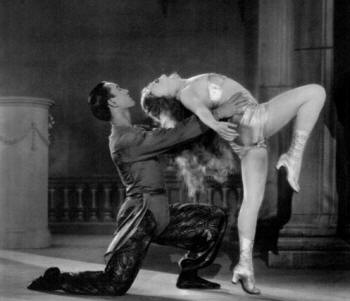 There were some forerunners of musicals in the 1920s.
These relied on live pit orchestras. One good example of this early
genre was The Merry Widow filmed in 1925
There were some forerunners of musicals in the 1920s.
These relied on live pit orchestras. One good example of this early
genre was The Merry Widow filmed in 1925
The first real musical was also the first sound picture: The Jazz Singer in late 1927.
Over time, musicals came to depend on dance as much as on song.
Many of the early musicals were reviews. These flourished during the 30s but disappeared after the war.
Another critical form of the musical was the "Backstage Musical." There were many versions of this but the general idea is that the key characters are actors and there is always a play presented. The leading early proponent of the genre was Busby Berkeley
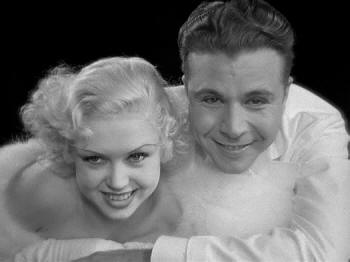 42nd
Street, 1933
42nd
Street, 1933
Directed by Lloyd Bacon (with Busbee Berkeley)
Staring: Dick Powell and Ruby Keeler (with an early appearance by Ginger Rogers)
42nd Street probably saved Warner Bros. from bankruptcy. It's a fast paced, clever musical that mixes Broadway veterans with virtual unknowns. It's a depression film, full of bitter wisecracks (that plays well in our own time). It also has the over-the-top choreography of Busby Berkeley (1895-1976) and is his first film. His style of production number is often imitated and parodied. Berkeley was a second generation film person. His mother had starred in silents. Berkeley was said to be inspired the marching formations of soldiers he'd seen in his experiences in World War I. He was a choreographer on Broadway in the 20s. Began to work in Hollywood in the early 30s. Worked on several films before 42nd Street, however this was his first really big film. He went on to do many similar (but increasingly extravagant) dance numbers for Gold Diggers of 1933, Footlight Parade, Gold Diggers of 1935. He worked with Esther Williams, for whom he did similar numbers with the actors swimming instead of dancing on stage (for example Million Dollar Mermaid 1952). If you go back and look at the "Just Dropped In" sequence from The Big Lebowski (number 17 in the film music portion of the class) you'll see that it parodies Berkeley in general and the "Young and Healthy" sequence from 42nd St. in particular.
42nd Street was directed by Lloyd Bacon (1889-1955) who was an extremely prolific director and also an actor in early films (He is in some of the early Charlie Chaplin shorts including the The Tramp)
42nd Street combined veteran stars (George Brent, Warner Baxter and Bebe Daniels) with virtual new-comers (Ginger Rogers, Dick Powell and Ruby Keeler)
Tim Dirks review at filmsite.org, (optional)
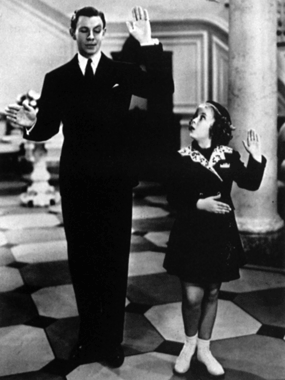 Little Miss Broadway, 1938
Little Miss Broadway, 1938
Directed by Ian Cummings
Staring: Shirley Temple and George Murphy
Shirley Temple (1928-2014) was one of the first and one of the most successful of the Hollywood child stars. She took her first role when she was 3 and the four films she made in 1934, when she was 6, got her a special academy award. The height of her popularity was from 1935-1938. During those years, she was Hollywood's biggest attraction. At the time Little Miss Broadway was made, her producers were afraid that she was getting too old for the kind of roles she was playing. They were right. She made two additional child films in 1939, but she was on her way out. She made several films as a teenager, but they were not particularly successful. Temple retired from acting in 1949. A first marriage to actor John Agar was unsuccessful. A second with businessman Charles Black worked. In the 1970s and 1980s, Shirley Temple Black became a important person in the Republican party. After a failed run for Congress, she was appointed Ambassador to Ghana by Richard Nixon. She later served in the Ford and Reagan administrations.
Shirley Temple films were ideal Depression entertainment. She was the little girl who could fix all the problems the grown-ups couldn't solve because she had a good attitude, energy, and was just so damn cute.
Not only that, but in this movie she dances with George Murphy (1902-1992), who later becomes US Senator from California. Both Temple and Murphy were Republicans, and in a sense the Shirley Temple movies, with their focus on self reliance and their examples of "nice" rich people (in this movie Sarah Wendling isn't, at least at the beginning, but Roger and Willoughby Wendling very much are) are rather conservative films.
The picture was directed by Irving Cummings (October 9, 1888 - April 18, 1959), born Irving Camisky in New York City, New York was an American movie actor, director, producer and writer. Cummings was known for the big splashy 1930s Technicolor musicals with popular leading ladies such as Betty Grable, Alice Faye, and Shirley Temple. he directed at 20th Century Fox.
Politics in 42nd Street and Little Miss Broadway: To some degree, 42nd Street and Little Miss Broadway represent the left and right in American politics respectively. As I mentioned above, it is perhaps no coincidence that both George Murphy and Shirley Temple were Republicans. Some critics (Susan Sontag in particular) see a fascist streak in Busby Berkeley's choreography. However, film critic Martin Rubin has argued (to my mind more persuasively) that Berkeley struck a balance between the individual and the collective that was attuned to Roosevelt's New Deal and the idea that society could survive and prosper if everyone pulled together. Shirley Temple movies, on the other hand, suggest that if people have a good attitude, energy, and a willingness to work, then everything will turn out OK (and it really helps if you're a cute little white girl).
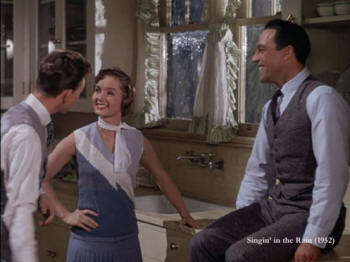 Singing
in the Rain, 1952
Singing
in the Rain, 1952
Directed by Arthur Freed
Staring: Gene Kelly, Donald O'Connor, Debbie Reynolds
Singing in the Rain was perhaps the most successful musical of its kind and one of the last musicals that wasn't simply an adaptation of a stage play. In a sense it's the last "true Hollywood musical" for many years (almost all the musicals that followed from the 50s to the current day are New York rather than Hollywood...they were adaptations of successful Broadway shows rather than stories made for the movies).
Singing was made by the Freed unit of MGM. The unit was headed by Arthur Freed (1894-1973), and it produced 40 MGM musicals including Meet Me in St. Louis, Annie Get Your Gun, Showboat, An American in Paris, Brigadoon, Gigi. Although other studios and other units made musicals, MGM's Freed unit was the most successful and best known musical production unit. Originally a piano player and lyricist, Freed had worked with the Marx Brothers. He was hired by MGM in the 1930s. His first big gig was as an assistant producer on Gone With The Wind. Freed was given his own "unit" in 1939. It's hugely successful after the 1939 production of Babes in Arms. Freed drew critical talent to MGM musicals including directors Vincente Minnelli (1903-1986), Stanley Donen, Busby Berkeley, and Charles Walters and actors Fred Astaire, Judy Garland, Gene Kelly, Lena Horne and many others.
Singing in the Rain relied almost entirely on recycled material from shows of the late 1920s and early 1930s. Set in the late 20s, it describes Hollywood's transition from silents to talkies. It's colorful, witty, and satirical and, although it is upbeat, it shares some of the traits of the film noir that were being produced at about the same time.
Tim Dirks review at filmsite.org (optional)
Roger Ebert Review (required)
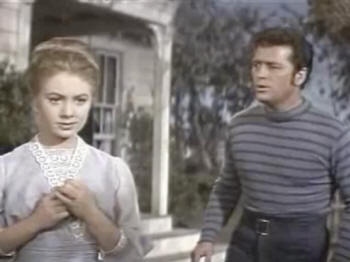 Carousel,
1956
Carousel,
1956
Directed by Henry King
Staring: Gordon MacRae, Shirley Jones

Don't misunderestimate Rodgers and Hammerstein (or do) (required)
Carousel was the second Rodgers and Hammerstein musical and opened on Broadway in 1945. Like Oklahoma, (the first R and H collaboration) which opened on Broadway in 1943, it was a spectacular success in its era. Richard Rodgers (1902-1979) was a composer who had collaborated with Lorenz Hart (1895-1943) on more than 40 Hollywood musicals and film scripts including: On Your Toes (1936), Babes in Arms (1937), I'd Rather Be Right (1937), The Boys From Syracuse (1938), Pal Joey (1940), By Jupiter (1942)). Their specialty was the sophisticated, witty musical.
Oscar Hammerstein (1895-1960) was a college buddy of Rodgers (at Columbia) who specialized in operetta. Rodgers joined Hammerstein to write Oklahoma shortly before Hart's death (the stage show premiered 3/31/43). After Hart's death, Rodgers and Hammerstein produced many of the most famous musicals of their era including: Carousel, The King and I, South Pacific, Flower Drum Song and The Sound of Music. Each of these were successful stage shows before they were movies. The Rodgers and Hammerstein collaboration produced a great many memorable songs but the shows and music was far more sentimental, sweet, and sincere than those of the Rodgers and Hart collaboration. Rodgers and Hammerstein's work was perfectly adapted to the cultural currents of the 1950s and the first half of the 1960s (though note that all their work was done in the 1940s and 1950s...Hammerstein died in '60.).
Carousel was based on the 1909 tragic play Liliom by Hungarian author Ferenc Molnar. It's a pretty odd story by modern standards (you can read a plot summary here). It was revived with some success in the mid 90s. A 2008 revival failed despite generally positive reviews. The 1956 film makes difficult viewing for a modern audience.
Critical changes were made first between the original play and R and H's stage version and then between the stage and film versions. In both cases, the changes were to soften the original play and make it a bit less tragic. Among these is that the key character suicides on stage but dies in an accident on film. The same character, allowed to return to earth after his death, fails to help his daughter in the original play but succeeds in the American version.
Watching "Clambake" after seeing extracts from 42nd Street and Singing in the Rain is pretty hard. The scene seems much more artificial, the music over sweet, the lyrics cringe-worthy ("The victuals we et were good you bet/the company was the same"). However, keep in mind that although "Clambake" isn't perhaps the greatest R&H song, it was a popular one from the show.
Carousel is a tragedy that could have been filmed in an edgy avant-garde way, but here it is made a sweet, bland, and colorful tear-jerker. The original hard ending was softened and the tragedy made into a feel-good film. This gives us a insight into the ways in which popular taste was changing in the 1950s. Despite the tearful ending of Carousel, in general the musicals that became popular in the 1950s and 1960s were far less cynical and satirical and far more conformist and optimistic than the musicals of the 1930s and 1940s.
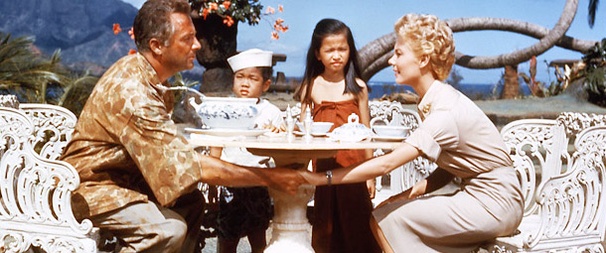 South Pacific, 1958
South Pacific, 1958
Directed by Joshua Logan
Staring: Rossano Brazzi, Mitzi Gaynor
(Most semesters not shown in class, please see it on your own).
South Pacific was the fourth Rodgers and Hammerstein collaboration and opened on Broadway in 1949. It might be the most politically charged of the R and H musicals and it certainly had some of the most famous music including "Some Enchanted Evening," which was frequently covered and was a #1 hit in 1949 and "I'm in Love with a Wonderful Guy"
Although the film is set among American sailors stationed in the South Pacific during World War II, it's fundamentally about race. The plot concerns two love stories: an American nurse from Arkansas (Nellie Forbush, played by Mitzie Gaynor) falls in love with a French plantation owner (Emile De Becque, played by Rossano Barzzi) but cannot (at least initially) accept his mixed race children. A secondary love story concerns Marine Lieutenant Joseph Cable and his love for a Polynesian girl. (spoiler: Forbush and De Becque overcome their problems and marry, Cable is killed in the war).
In the scene we (occasionally) play features the song "You've Got to be Carefully Taught." Forbush rejects de Becque because she can't accept that he was married to a Polynesian. Cable sings that racial prejudice is not innate but must be "carefully taught." In my opinion, the scene doesn't work in the modern world. It's so overwrought that it becomes funny rather than tragic. However, it was radical in its era, and the song has been covered by a variety of artists, including James Taylor.
The play (and film) created enormous controversy, particularly in the South where in 1953, in Atlanta legislators tried to outlaw it as having "an underlying philosophy inspired by Moscow" and State Representative David C. Jones claimed that a song justifying interracial marriage was implicitly a threat to the American way of life. Note that to make race a focus of the play and film was a very specific conscious decision by R and H. It wasn't really the focus of the Mitchner short stories (Tales of the South Pacific) on which the show is based. In context, it was part of a broader effort by Northeastern liberal intellectuals to tie the civil rights struggle to anti-communism.
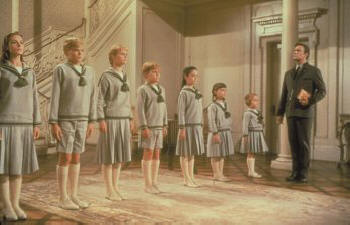 The Sound of Music, 1965
The Sound of Music, 1965
Directed by Robert Wise
Staring: Julie Andrews, Christopher Plummer
(Most semesters not shown in class, please see it on your own)
In its era, The Sound of Music was unbelievably popular. It surpassed Gone With The Wind as the greatest box office draw (before it was outstripped by The Godfather in 1972). In many ways it is the height of the 1950s/1960s musical genre. It was made from a 1959 stage show of the same name. It was wholesome, happy, had singable tunes and stage settings that were both spectacular and realistic. It was also, basically, the end of its genre of musical. After the success of SoM, Fox tried three additional blockbuster musicals: Doolittle (1967), Star (1968), and Hello Dolly (1969). None were successful. SoM was directed and produced by Robert Wise, very well known and experienced director who also did movies such as West Side Story, The Andromeda Strain, Star Trek (1), and over 40 others.
In many ways, The Sound of Music is a happy upbeat love story about the Nazis! Although the play is set in the disaster of the Nazi take-over of Austria, the focus is really on the various love affairs and on the characters of Maria, the governess and the von Trapp children. Revealingly, the original play included a kind of nasty cynical song "No Way to Stop it" (the song argues against resistance to the Nazis and for the naked promotion of the self). The song was deleted from the film version.
The scene we (occasionally) play from this: 16 going on 17, is cute... actually salacious for its era, but again pretty hard to watch in the current day. Here's a link to see it.
Tim Dirks review at filmsite.org (optional)
In many ways, The Sound of Music really represents the bitter end of 20th century musical film. Broadway musicals, of course continued. Some of the great Broadway shows of the 1960s were Funny Girl, Hair, Oliver!... Most of these were made into movies but none of the movies had either the success or the cultural imprint of the earlier R & H musicals.
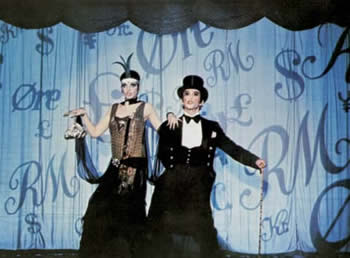 Cabaret,
1972
Cabaret,
1972
Directed by Bob Fosse
Staring: Liza Minnelli and Joel Grey
Cabaret won 10 academy awards, but lost to The Godfather for Best Picture (that was a year! Other films of that year include Deliverance, The Candidate, and Last Tango in Paris). Cabaret was a 1966 Broadway show based on an earlier play (I am a Camera) based on Christopher Isherwood's 1939 novel Goodbye to Berlin.
Cabaret was directed by Bob Fosse (1927-1987), choreographer, director, producer of perhaps the best of the 1960s and 1970s Broadway musicals and film. His credits include Damn Yankees, Pajama Game, Sweet Charity, Pippin, and Dancin, Lenny, All That Jazz and others. Fosse's style was a radical break with the musical styles of the 1940s and 1950s. He brought jazz dance to the theater (and sex as well).
The scene we play here, "Money Money Money," is everything that the R and H musicals were not: hard edged, cynical, sexual, and much more in tune with the social upheavals of the era from 1965 to 1975.
Just as Sound of Music really included only one hard-edged cynical song "No Way to Stop It," Cabaret includes only one really sweet song: "Tomorrow Belongs to Me." In the play, this is originally sung a cappella by a male voice choir. However, in the film version it's sung by the Hitler Youth. Thus, while earlier stage musicals were sometimes sweetened as they transitioned to the screen, Cabaret was soured! The song has been covered several times by neo-Nazi musicians (particularly the British skinhead group Screwdriver). "Tomorrow..." is, IMHO, among the most disturbing moments in musical film.
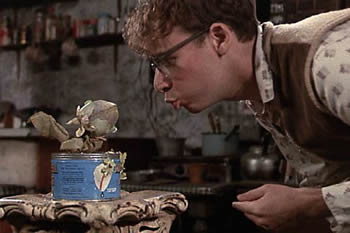 Little Shop of Horrors, 1986
Little Shop of Horrors, 1986
Directed by Frank Oz (b. 1944)
Staring: Rick Moranis, Ellen Green
Little Shop was originally a 1982 off-Broadway musical made from the 1960 Roger Corman (b. 1926-) film of the same name. The film was not a musical and was "serious." Corman, of course, was the director of such Hollywood classics as A Bucket of Blood (1959), The She Gods of Shark Reef (1956), and Attack of the Giant Crab Monsters (1967) (he's got over 400 other director or producer credits.) .
Little Shop was directed by Frank Oz (1944-), who you might know better as the master puppeteer who brought you Bert, Cookie Monster and Grover (as well as Animal, Fozzie Bear and Miss Piggy ... and not to mention Yoda). Oz has also had a very successful directing career that includes Dirty Rotten Scoundrels (1988), What About Bob (1991), Housesitter (1992), Indian in the Cupboard (1995), and In and Out (1997).
In a sense, by the 1980s, although Broadway musical shows continued to soldier on, the musical as a film genre had played itself out. The only musicals that could become popular were either films that more-or-less parodied the genre (like Little Shop or Hairspray 1988) or animated films like An American Tail (1986). Dance films (like Dirty Dancing 1987) remained popular, but that's a different genre (the same might be said of the two hit religious musicals of the era: JC Superstar (1973) and Godspell (1973).).
Starting in the 2000s, there was a substantial revival of film musicals. This was signaled by the 2002 Best Picture award given to Chicago, a classic backstage musical (but one that had been a play in 1975). Chicago was the first musical to win Best Picture since Oliver! in 1968 (and that's not remembered as great decision. Looking back, the most memorable films of that year weren't even nominated. They included 2001: A Space Odyssey, Rosemary's Baby, and Planet of the Apes).
The revival of musicals that began with Chicago continued, primarily on TV, with the success of shows such as Glee (2009-2015) and Crazy Ex-Girlfriend (2015-2019) and was capped (at least for the moment) with La La Land (2016) which was the first "true" Hollywood musical (again, in the sense of being made originally for film rather than derived from a stage play) since the 1950s. La La Land was nominated for 14 Oscars and won 6 (but not Best Picture. That one went to Moonlight in a famously messed up presentation).
Next: Short Subjects